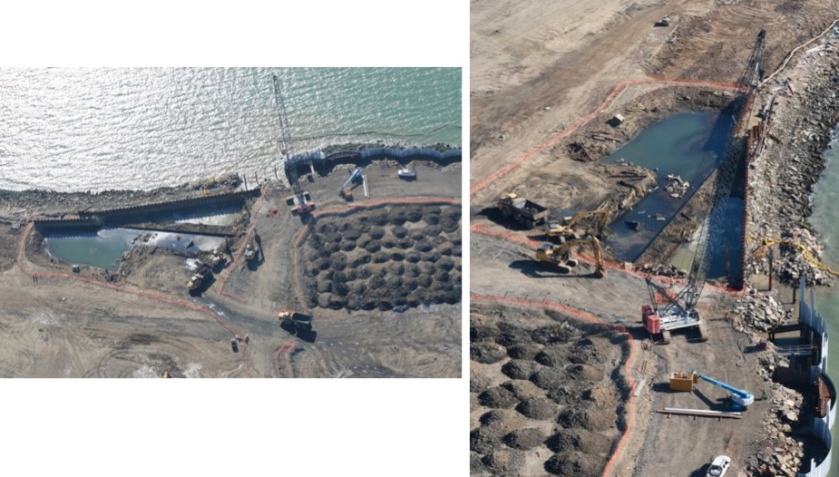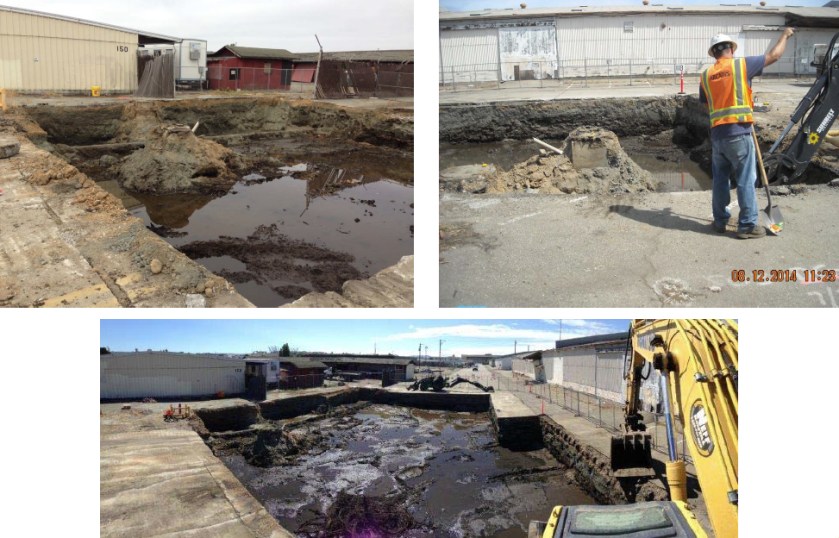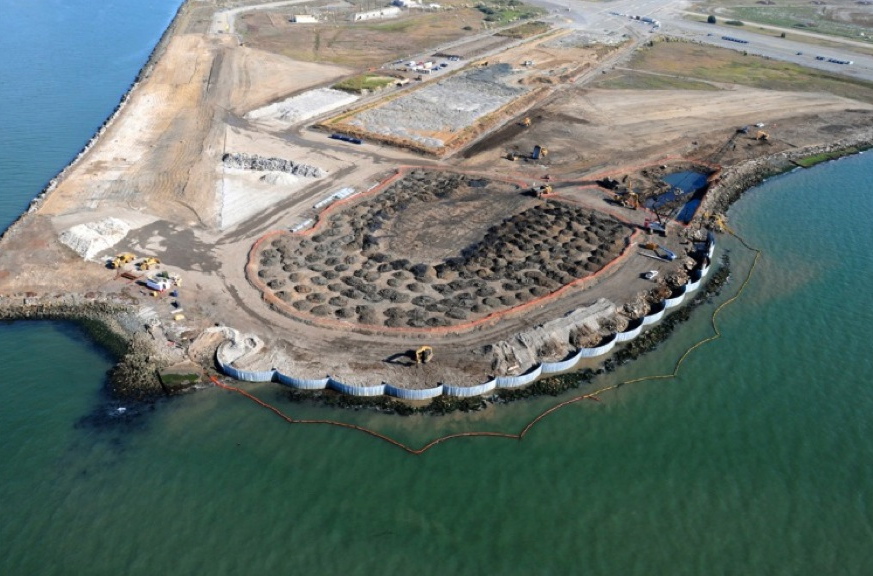Navy environmental cleanup operations at Alameda Point ran the gamut during the summer and fall of 2014.
Operations included using bacteria to clean up groundwater, grinding radium out of a building floor, digging up lead-contaminated soil, constructing a metal shoreline waste barrier, digging up shoreline waste, preparing to install a 30-acre soil cover, constructing a new shoreline wetland, checking drain lines for contamination with cameras, and demolishing a several-acre temporary concrete drying pad near the old Control Tower.

One site where bacteria are being used is under Alameda Point Storage at the corner of W. Oriskany Avenue and Central Avenue. Benzene contamination is in the groundwater there. The contamination area, referred to as a plume, was investigated back in 1995 and shown to be slowly dissipating due to natural bacterial action. But the bacteria need oxygen, and the storage buildings and pavement prevent adequate oxygen getting into the ground. The Navy’s plan included installing vent pipes into the ground for air circulation and giving the bacteria a boost with chemical injections that release oxygen and also help to break down the benzene hydrocarbon. The bacterial process is referred to a bioremediation.

Another type of bioremediation was undertaken at Hangar 41 next door to the Bladium Sports Club on W. Tower Avenue. At this site the Navy came back to do more cleanup on groundwater that is contaminated with a solvent, which is different than the fuel-related contamination under the storage facility. The Navy’s 2010 treatment of the groundwater at Hangar 41 using chemicals to break down the solvent was successful in eliminating most of the contamination, but fell short of the goal.

This summer’s follow-up work at Hangar 41 was designed to give existing bacteria in the ground some added nutrients to finish the job. Instead of oxygen, this cleanup problem required sending in food for the bacteria in the form of food-grade lecithin. To get the lecithin into the ground, over 221,000 gallons of water were pumped out of the ground, injected with lecithin, and pumped back in. The lecithin ferments and produces hydrogen that is then used as an energy source for the bacteria in digesting the solvent.

Out at the northwest corner of Alameda Point, the Navy completed the installation of a metal barrier along several hundred feet of Bay shoreline. This is the area where the Navy burned waste and operated an underground waste disposal area before the runway was extended. The soil is being scanned for radiation and hot spots removed. A new wetland area has been readied along the Oakland Estuary, and later this year and into next year the Navy will be installing a three-foot soil cover over the runway and the rest of the 30-acre site. When completed, it will be available for recreational open space trail use.

Next to the old commissary near Main Street and Appezzato Parkway the Navy dug up an area about the size of a swimming pool to remove soil contaminated with lead. The site is part of the proposed “waterfront town center” where the city is considering selling 68 acres for the first phase of commercial and residential development.

Up on the second floor of Building 400 on W. Tower Avenue, the Navy removed a few isolated portions of the concrete floor that recent scanning showed to have low levels of radium. Radium-226 was used in this building as part of the luminescent painting of aircraft dials and markers.

Across the street at the massive Building 5 – the original site of radium dial painting and the main aircraft reworking facility – more investigation work occurred on potentially contaminated storm drain lines and a waste line. The Navy replaced a section of a storm drain, and will decide soon whether to remove sections of the waste line where low levels of radium may have leaked out of pipe. The Navy has balked at removing the entire several-hundred-yard industrial waste line, saying that most if not all of it can be left in place and the city can work around it. The city’s infrastructure plan calls for use of concrete utility trenches in selected areas to shield workers from latent contamination exposure.

The temporary concrete drying pad used for dredge sediment dewatering and testing on the northwest side of the Seaplane Lagoon has been demolished. It’s sitting in a massive pile next to the Control Tower and will soon be transported out to the northwest part of the runway area. The concrete will be used as part of the cover over one of the final cleanup sites there.

But the area where the drying pad was located will remain fenced off to serve as a work site in case any of the above-mentioned waste drain line near Building 5 has to be dug up, inspected and disposed of. It will be some time in 2015 before the fencing at the west side of the Seaplane Lagoon is gone.




































It’s crazy how much work the Navy is doing. Great information!
LikeLike
Pretty venue for a cleanup project (at least the area by the ocean)!
LikeLike